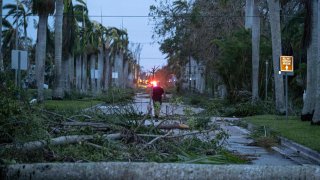
- Ian was downgraded to a tropical storm on Thursday after slamming into Florida's southwestern coast on Wednesday as a category 4 hurricane with sustained winds of about 150 mph.
- Homeowners insurance deductibles for weather-related damage are often a percentage of your home's insured amount.
- It's also important to consider whether you need flood insurance, which generally needs to be obtained separately.
If you're far from the destruction caused by Hurricane Ian in Florida, you may be thanking your lucky stars that your house wasn't in the storm's path.
Nevertheless, you also may want to consider whether you are prepared financially if disaster were to hit closer to home.
Whether you live in an area prone to hurricanes, tornadoes, flooding, hail, wildfires or severe storms — all of which seem to be becoming more prevalent amid a warming climate — it's important to know which types of weather-related damage your homeowners insurance covers, excludes or charges a separate (and likely higher) deductible for.
We've got the news you need to know to start your day. Sign up for the First & 4Most morning newsletter — delivered to your inbox daily. >Sign up here.
More from Personal Finance:
Here are some ways to trim your tax bill
How to get the best return on your cash
These resources can help struggling seniors
"Take time to understand how the policy [covers] severe weather and natural disasters," said Steve Wilson, senior underwriting manager at insurer Hippo.
Ian was downgraded to a tropical storm on Thursday after slamming into Florida's southwestern coast on Wednesday as a powerful category 4 hurricane with sustained winds of about 150 mph. The storm could regain hurricane strength as it heads into the Atlantic Ocean and then back toward the U.S. southeast coastline, according to the National Hurricane Center.
Money Report
It's worth noting that before Ian made landfall, the home insurance market in Florida was in turmoil due to rampant roof replacement claim schemes and excessive litigation filed against property insurers, said Mark Friedlander, spokesman for the Insurance Information Institute. In 2021, Florida homeowners saw their premiums increase by an average of 25%, compared with 4% for the rest of the U.S.
"With a projected property damage loss in excess of $30 billion from Ian, we expect the market to become more unstable," Friedlander said.
Regardless of where you live, here's what you should review in your homeowners insurance policy for weather-related coverage.
Weather-related deductibles can be pricey
While many weather-related events are covered under the standard part of your policy, some fall under a different section that comes with a separate deductible.
If you live in a state along the East Coast or Gulf of Mexico, there's a good chance your policy has a hurricane deductible. Likewise, in states more prone to wind-related events — i.e., tornadoes — you're likely to have a wind deductible.
Either way, those amounts typically range from about 1% to 5% (with a minimum $500) depending on the specifics of your insurance. Some homeowners might opt for an even higher deductible if it's available.
Be aware that for those percentage-based deductibles, the amount is based on your insured value, not the damage caused.
So if your home is insured for $500,000 and you have a 5% hurricane deductible, you'd be responsible for covering the first $25,000 regardless of the total cost of the damage.
Also, earthquakes are not covered by standard homeowners policies, even in quake-prone California (you'd have to purchase separate insurance). Nor, typically, are other types of earth movement (i.e., landslides, sinkholes).
Don't overlook your flood risk
Flooding has become an increasing risk for homeowners as sea levels rise and storms grow larger. Yet just 15% of homeowners are insured to protect against flood damage.
"One of the most important policies to consider for hurricane protection that can be overlooked is flood insurance," Wilson said.
In Florida, more than 80% of homeowners do not have flood insurance, Friedlander said. "With catastrophic flooding from Ian occurring across the state, many homeowners will not have financial protection from these losses," he said.
Those homeowners will be able to apply for grants from the Federal Emergency Management Agency, but the amount typically only covers part of your loss. For instance, after 2017′s Hurricane Harvey, which dumped as much as 60 inches of rain in some spots in Texas, the average FEMA grant for individuals was $7,000, while the average claim through the National Flood Insurance Program was more than $100,000.
If you're in a high-risk flood zone, your mortgage lender likely requires you to have flood insurance. Yet 1 in 4 flood claims come from homeowners outside of those areas, according to FEMA.
You can get coverage through either a private insurer or the federal program (which is how most homeowners get a policy). There are exclusions and limitations on what is covered, however. And, outside of a few exceptions, policies take 30 days to become effective.
The average yearly cost is $985, although that can vary widely. FEMA recently implemented Risk Rating 2.0, an actuarially sound approach to better assess individual flood risk, which has caused premiums to rise for some homeowners and fall for others.






